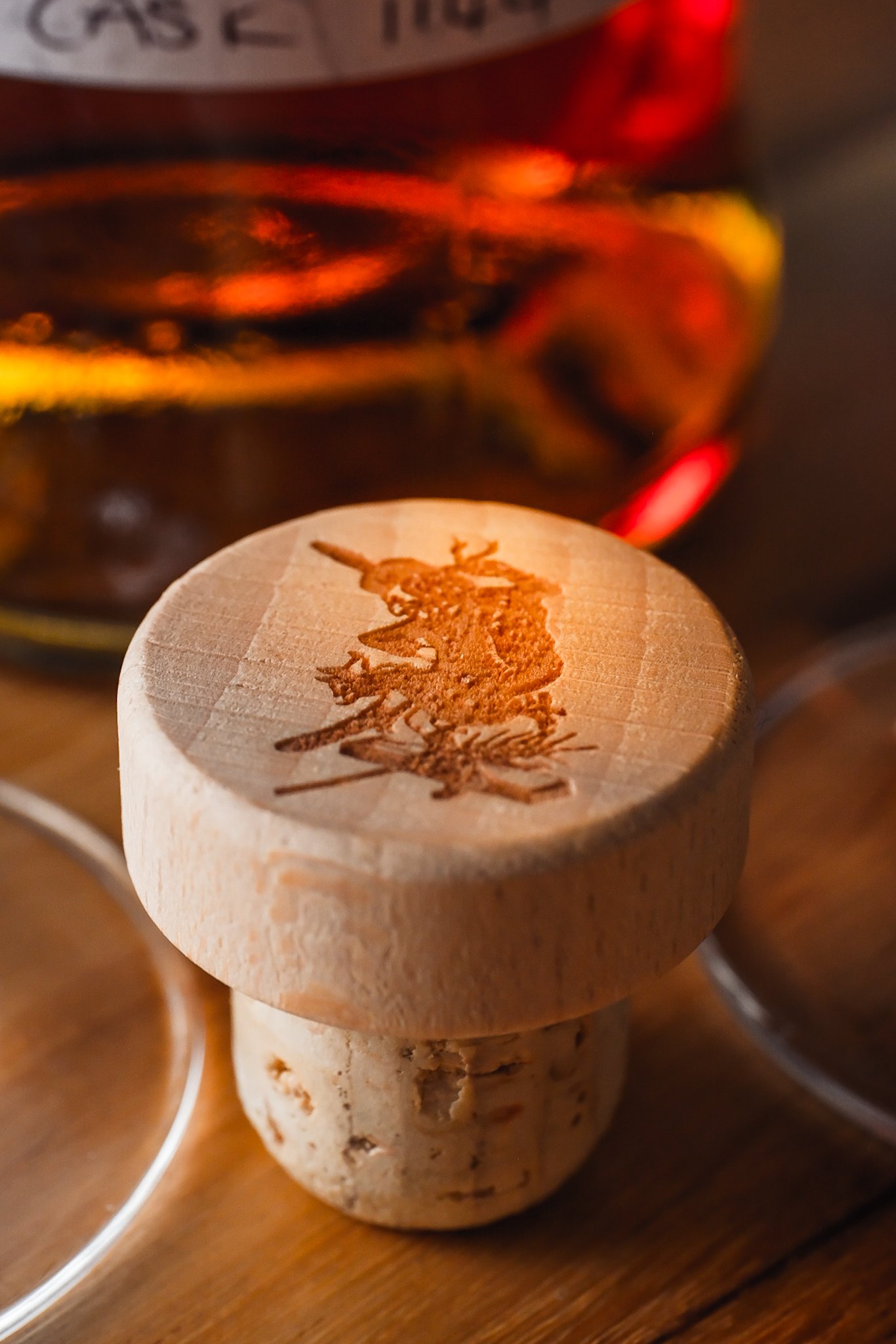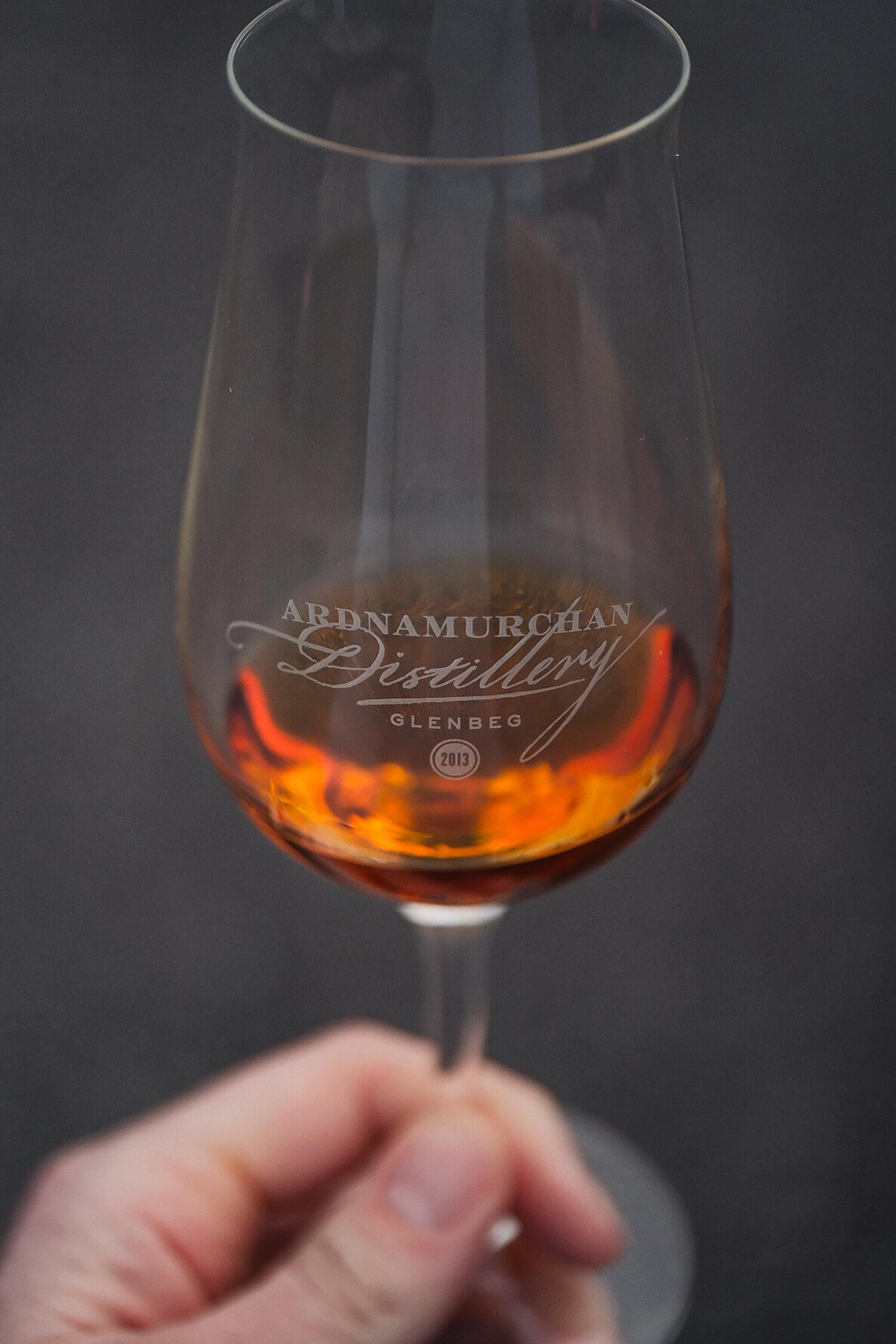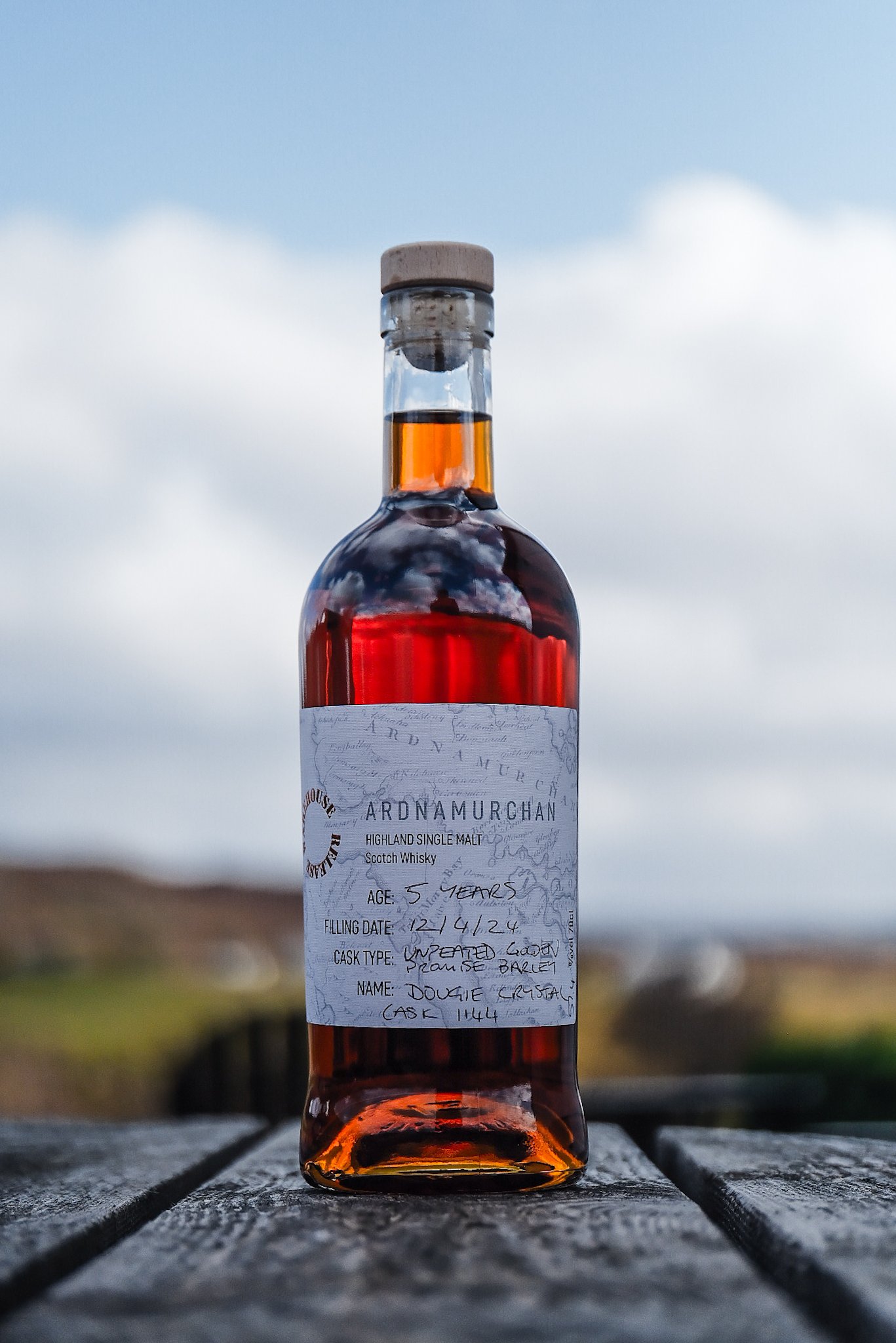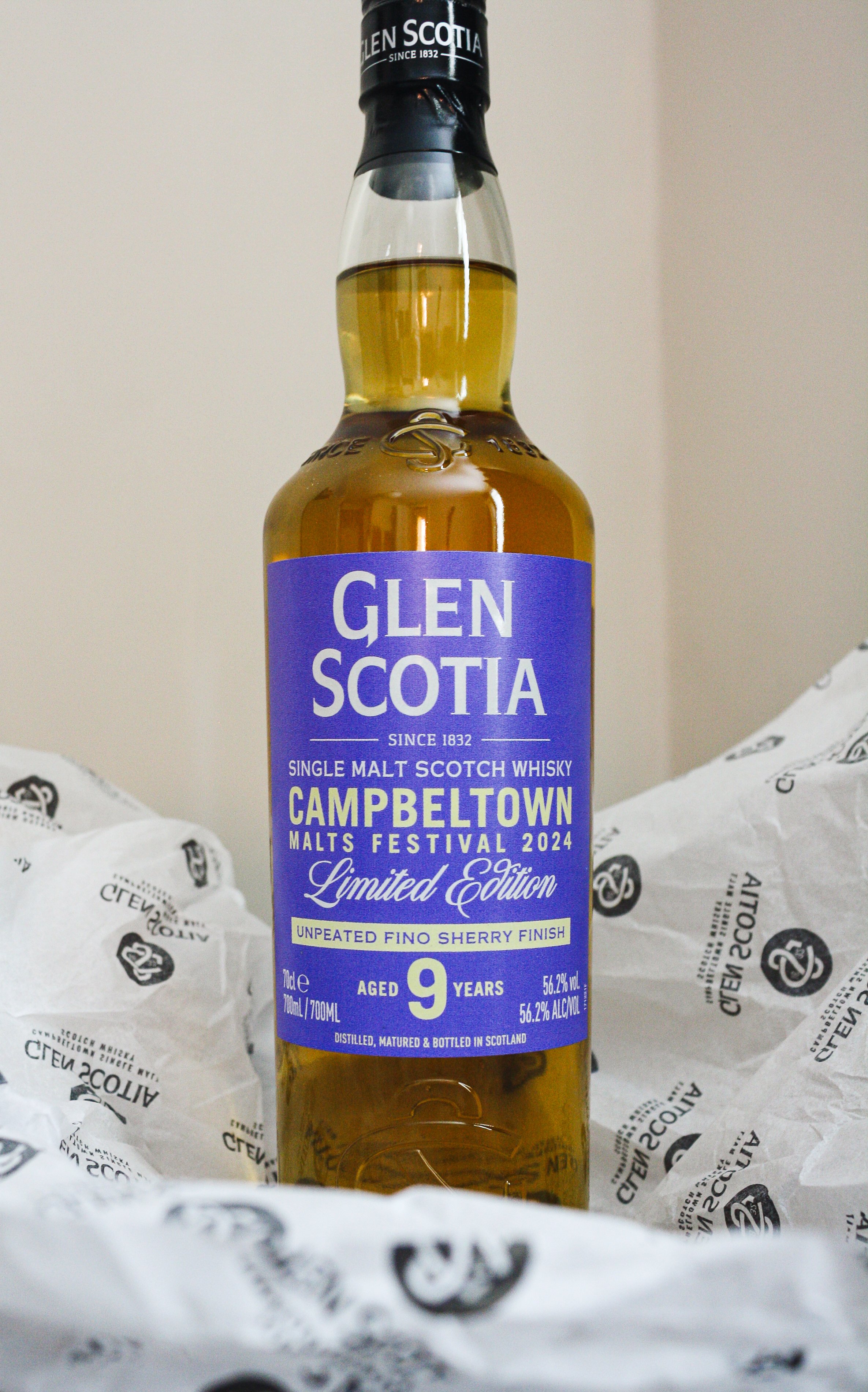Ardnamurchan Golden Promise
Distillery Exclusive | 57.4% ABV
Score: 9/10
Exceptional.
TL;DR
The best Ardnamurchan whisky I’ve tried to date.
Back in the Ardna Saddle with a Bang
Talk fondly enough about something, for prolonged periods of time, and soon that thing will become tiresome for those on the receiving end of it.
It’ll become boring and could very well impact the reputation of the thing you speak so highly of. Multiple people talking about it, for prolonged periods of time, compounds the problem. Oh, here he is again. What is it this time? More Ardnamurchan probably? Bore off, we’re fed up hearing about it. One person’s golden chalice is another person’s foam cup.
For 2.5 of my 3 years in whisky excitement I’ve regarded Ardnamurchan Distillery as being a leader in ‘new wave’ whisky; that of under a decade in distilling years. The whisky that they’re putting out, from their core range AD/ all the way through their batch series (rum, cask strength, sherry, Madeira and maybe soon to be Sauternes), their hand-fill curiosities and up to their single cask, blue bottle releases, and even the independent bottlings, have been either engaging, swoon-worthy, impassable on my whisky shelf or, often, all three.
With strict exception of the Rum Cask Release and the April Fools bottlings, which were perhaps more field-of-play defining than they were level increasing, every Ardnamurchan whisky that has passed my thin lips has been brilliant.
Approaching year end 2023 I reviewed what, for many, would have been the peak of Ardnamurchan excitability: two bottles of whisky that I’d watched coming into the world, sampling from cask in their warehouse the very same liquid many months before. Yet after the clock struck midnight I realised, with a growing sense of reluctant acceptance, that my time with Ardnamurchan was, for the moment, coming to an end.
I needed a break, both from my relentless pursuit of Ardnamurchan whisky in all its guises, and from the fear of becoming ‘that guy’. Already there were calls appearing of being an Ardna shill, such was my persistent and unwavering celebration of Ardnamurchan whisky. My genuine love of spending time with the folk who make, present and promote Ardnamurchan whisky had to be slipped into a temperate oven, rather than sit on the full gas burner, because I needed perspective. Distance, they say, makes the heart grow fonder.
Now and then I’d dip into their AD/ and see how it compared to other things, like Old Pulteney Huddart or Glasgow Cognac, Talisker Parley or Tomatin Amarone. Ardna AD/ always came out of the dusty garage and reigned supreme because I just bloody love their whisky. But you’ll have noticed, if you follow along with my silly wee journey, that there’s been a dearth of Ardnamurchan reviews, or even pictures, in almost 5 months. I’ve not opened a new bottle or sought out something new (even if there's been few new releases in that time either from AD or indies) because I wanted to expose myself to new things, stretch my elbows a bit and broaden my palate.
In that span of time the team at Ardnamurchan have been, looking through their Instahoot, trekking the globe, spreading the gospel of their whisky to new markets; a non-stop commitment to making sure that Ardnamurchan whisky is available and enjoyed the world over.
It’s been a strange time for whisky, coming into 2024 with talk of smaller, newer distilleries really struggling in the first quarter of the year, with even more worrying noise that some distilleries could be shutting their doors so soon after opening them. Yet in all of the discourse I rarely, if ever, saw Ardnamurchan mentioned.
This year Ardnamurchan Distillery will celebrate 10 years of distilling at Glenbeg and I don’t think I’d be out of line saying that, through consistent quality of product and authenticity of message, they’ve positioned themselves as the most exciting, and the most resilient, new-wave distillery around in scotchland.
Many people hold up the double-digit age statement as confirmation of legitimacy, of being ‘mature’ whisky, and not just some new-make tinted with wet cask influence. I’ve never conformed to this thinking, because good whisky is good whisky.
Regardless, Ardnamurchan will secure that so-called legitimacy soon. Yet for over 3 years Ardnamurchan have been putting out whisky that belies any age statement, offering whisky that tastes and smells much older than it is - complex, engaging, meandering and robust. Still, reaching double digits in any business is a huge feat of endurance, compromise and hard graft, and Ardnamurchan certainly seem to do such corporate things with a lightness of spirit and fun that inevitably draws so many to their brand.
Review
Ardnamurchan Distillery Exclusive, FF Sherry Octave Cask 1144 Unpeated hand-fill, Golden Promise Barley, Warehouse 1 matured, 57.4% ABV
£70 (£63 paid with AD/Venturer discount)
The Crystal massive recently volleyed down to the borderlands to make the acquaintance of our incoming hairy bullet, a 5 week old cockapoo. Mini Crystal was so made up, holding that wee whisky coloured fluffball, that our hearts glowed with wholesome pride, and the prospect of having our wee girl not feel so isolated here on the Misty Isle is a worthy enough reason to suffer through allergies and sleepless nights that will no doubt come in quick order.
The day before we left the island on our 530 mile, 24-hour round-trip to the borderlands, Ardnamurchan posted a quick video of DJ presenting a new hand-fill cask they’d installed in the visitor centre at Glenbeg. I knew before I even tapped the sound on, that I somehow needed to find a way to try it.
Luckily for me and through no small stroke of insufferable Dougie enabling, my whisky pal and accomplished photographer and videographer Alex, aka Scotland on the Shot, was passing by the distillery the day we were travelling down.
A coming together was arranged in Spean Bridge and, through a quick car park exchange, I came into possession of a bottle of 5-year old Ardnamurchan whisky, distilled using Golden Promise barley and aged in a single PX sherry octave. Ardnamurchan like using these wee diddy octave casks because it accelerates the maturation characteristics of their spirit, especially when placed in Warehouse 1 with its upper level concrete floor heating the warehouse, to further accelerate the maturation. Tyree will be reeling at my over-simplification of this, but he knows I mean well.
DJ spoke of this being a special whisky because of the use of Golden Promise barley. I don’t think I’ve tried any whisky using this revered strain yet, but talk of an extra oiliness of spirit and a widened depth of flavour make me more than eager to try it. I carried the bottle all the way to Ayr and back again, opening it the moment the car was unpacked and the oven was turned on for our pizza dinner. It’s visually spectacular in colour - mahogany red/toffee colour and jingos, does it cling to the glass. Off we go, into the first new Ardnamurchan since December.
Score: 9/10
Exceptional.
TL;DR
The best Ardnamurchan whisky I’ve tried to date.
Nose
Vivid. Malty. Thick sticky apple pie. Spongy, savoury, grainy. Syrupy. Big syrup - golden syrup, maple syrup. Buttery jammy biscuits.Salty red. Cinnamon cereal - Golden Grahams. Cedar gym hall. Big bright reds - strawberry, raspberry, little cherry maybe. A savoury wave - chalky. Back to juicy. A citrus element - kiwi or grapefruit. Oven chips in a floury roll and a thick spread of Lurpak. Pineapple freshly sliced. Polythene sheet.
Palate
Massive red magic. Thick. Syrupy. Mouth coating, enveloping. At once big sweet red but big malty yellow too. It has a depth I’ve not noticed in Ardna before - a wider flavour stage. Alongside the expected cedars, red fruits, stewed apples and toffees, is a bready, spongy, cakey thing. Vanilla sponge, but I can taste the flour. It’s luxurious syrupy dreamland - very little heat, just silk sauce of maple syrup and pepper, sugar and spice. A deep earthy, vegetable thing - not dirt or funk, a grounding. Might be the malty thing again. Sometimes a sour note appears, balancing the sweeties, but it’s fleeting, interesting and complimentary.
The Dregs
Immediately I realise this is an Ardnamurchan whisky like no other. It’s undeniably Ardna whisky - the mineralic saline quality of the spirit is there, but if you imagine the flavour stage as being akin to a physical stage, this is a stunningly illuminated Royal Albert Hall of a whisky. It’s stopped me in my tracks. The initial impression from the neck pour is the most saturated syrup sponge I’ve ever sunk my teeth into. Moist, rich, thick, syrupy, bready sponge. Dense, decadent, and wall to wall flavour. I chew on this like I’d chew on a bouncy ball - jawline enhancing.
Alongside the unzipping of this hand-fill I reached into the small unopened crate of whisky in the garage and picked out a bottle of single cask Ardnamurchan, bottled for Inverness Whisky Shop and their opening in late 2023. This is an interesting bottle of Ardnamurchan because it’s not like the other single cask Ardna’s around, instead being a vatting of 3 different octave casks - 1x unpeated sherry octave and 2x peated sherry octaves; one octave for each of the 3 founders of Inverness Whisky Shop.
I thought that it would be cool to see how the two octave matured whiskies spoke to each other, but within a matter of seconds I realised that this would be like comparing a first-class cabin on a 787 Dreamliner with the other…less roomy seats. They’re all on the same plane but not offering quite the same experience. So whilst this review was intended to be a twofer, I’ll keep the Inverness bottle for assessment alongside other single casks I have kicking about for fairness. Such is the excellence of the Golden Promise that even this unique bottle of tri-cask excitement is overshadowed.
Golden Promise barley, a heritage barley originally created in the 60s, is really expensive to use simply because the yield rates are so low compared with more modern varietals, like Laureate. From a layperson’s perspective it looks like the wee kernels of barley are physically smaller, so I guess that contributes to the yield issue - you get physically less for your money?
Whatever the reason, the result of using these wee kernels is a spirit of far higher oiliness, of marked increase in viscosity over more readily available barley strains. The unctuous new-make, matured in primo casks, delivers a visibly more textural whisky in the glass - it sticks to copita sides, and in facehole renders mouth coating stickiness like nothing I’ve experienced so far in whisky.
There’s a far earthier, more savoury component in this whisky compared with other Ardna whiskies. Not a flattening, rounding-off effect of something like the Rum Cask Release, but more a robust and deep malty flavour surrounding the coastal Ardnamurchan character. It’s a far richer flavour stage supporting an already expansive assembly, but… why is it so damned different?
What is it about Golden Promise barley that makes stuff distilled from its kernels so much more syrupy? It’s a question I need answered, but don't really have the experience to do so myself. Luckily on Team Dramface we have someone who knows a thing or two about this stuff. Tyree, if you please:
The driver of new varieties has always been increased agronomic and spirit yields, while being hardy enough to grow/farm easily; for instance re: hardiness, Golden Promise had shorter stems and thus suffered less from lodging (basically bending/breaking of the plant stem, lodging the plant in the dirt and tainting the barley). It was also early ripening, had short dormancy and had nicely uniform grain sizes (even water uptake for malting), all of which are appealing to work with. Most importantly, it had good spirit yield compared to its contemporaries.
Spirit yield is basically all to do with how much starch is in the grain; more starch leads to more sugars, more sugars=more booze. Because there's only so much room in grain, the more stuff you have that isn't starch, the less starch you have as a total percentage of the grain weight. There's an equation that relates to this named after Len Bishop (Bishop's formula); essentially, the more nitrogen in the barley, the less starch. Nitrogen directly correlates to protein content, and protein content impacts a number of flavour and production mechanisms.
Higher protein means higher amylolytic enzymes for starch conversion for instance, which is why higher nitrogen malts are used in grain distilling (non-malted grains have functionally zero amylolytic enzyme activity). Protein content also impacts fermentation, both by yeasts and bactereia. Both can metabolise protein for energy, creating a range of compounds as a result.
In yeast, protein catabolism is a source of fusel alcohols, which are one of the main compound classes which make spirits oily and viscous (diacetyl being another, which is also impacted by yeast activity, which again is dictated by a number of conditions, including free amino nitrogen content, which is directly related to protein content in wort).
Long story short; as time has progressed, we've gotten better at breeding lower and lower nitrogen barley varieties for malting in order to increase starch and spirit yield, but this has caused a decrease in protein content which can impact flavour. Similar arguments could possibly also be made for other things like husk lignin content, polycarp/testa polyphenol content etc, but protein is the big one.
So, with that in mind, what about Golden Promise specifically? Well, there's really not that much available data on it (at least in the cursory look I've just done). To be able to point a finger and say "That's what made it so good for making whisky!" we'd need a comparative study that grew a range of historical and modern popular varieties under similar conditions, malted them all under controlled conditions, turned them into wash under controlled conditions, then compared the grain, wash and/or spirit distilled from wash via GCMS, HPLC, NIR and other chemometric tests to analyse for protein content, precursors, metabolites and volatile compounds of interest.
Whilst such a study doesn't seem to exist (again, at least that a cursory search could find) there is a very interesting study comparing Golden Promise to two related strains (link here) which found it to produce beers higher in ethyl hexanoate, linalool and dibutyl oxalate. The same study found Golden Promise to have the most positive sensory characteristics, though that doesn't necessarily mean much, and certainly doesn't indicate any of the underlying chemistry without more context.
Tyree Kai
So in other words, we dinnae ken exactly why Golden Promise creates such a viscous, oily dram, but it’s likely because of the inherent fusel alcohols being so much betterer in Golden Promise. Or something like that. But not content with that answer, Tyree reached out to his pal, Epigeneticist Dr Paul Gooding, who studied Golden Promise for his PhD, to see what he had to say of it:
The question you pose is a tricky one. Golden Promise is a gem of a variety and as you are aware it’s still worshipped and revered throughout the Western World for brewing (and in some cases still for distilling). It certainly has wonderful properties for malt flavour and mouthfeel for beers and balances extremely well with high alpha acid hops, probably due to its residual sweetness. It also has great processability as a malt.
It was extremely popular with distillers too, back in the day, but I suspect this was a product of geography rather than being the most perfect malting barley for distilling. Golden Promise, due to many of the traits you mention (induction of a dwarfing genotype is also associated with small grain with very consistent size and highly branched starch), could be grown in the far Northern reaches of England and across the border into Scotland. Before Golden Promise, most barley grains or malted grains were imported into Scotland from Central England. The exact genetics of why it grows well that far North are unclear to me, but I believe there is a reasonably recent study from the Carlsberg Laboratories that has probed the genetic basis of GP’s success.
Certainly, Golden Promise was able to adapt to local climatic conditions and soil composition in Scotland. Therefore, being local to the Scottish Distilleries it was used widely, and folk soon noticed that those prized flavour profiles in beer were carrying over into the distillate, imparting a rich, malty sweetness that melded perfectly with well-chosen oak for maturation.
Sadly, GP was susceptible to many of the UKs most common fungal pathogens such as powdery mildew. It also yields a lot less than more modern varieties and due to the highly branched starch (great for leaving dextrins in beer for mouthfeel and head retention), lots of non-fermentable sugars are lost, meaning lost yield of alcohol after fermentation and distillation. Modern distillers want every carbon molecule to yield ethanol! It’s a shame that flavour profile is not so highly sought!! But money talks, so less reliance on herbicides, pesticides, greater yield and less modified starch makes GP uneconomic to use apart from for bespoke or boutique projects (or people wanting a point of difference or a magical story to tell!).
I hope this is vaguely useful, lots of words, not too much scientific reference, but I believe all I’ve said is true and the reason for GP’s notoriety, legendary status, but ultimate demise.
If you get a chance to try any old Macallans, let your tastebuds decide whether the people or the accountants are right when it comes to the utilisation of Golden Promise malt compared to the high yielding, pathogen resistant modern varieties.
Dr. Paul Gooding - Epigeneticist
It’s fascinating, isn’t it, to read why Golden Promise was used so much in the ‘good ol’ days’ but over the decades fell into obscurity owing to the susceptible nature of harvested grains to disease. The world is always changing and with each inexorable moment that passes, so too do these heritage grains fall by the wayside.
I’m absolutely not smart enough to even comprehend why they don’t just…make another Golden Promise grain that’s resilient to the new world? A button push here, a fiddle there, a dance over yonder and blam - a new grain variety that delivers the same properties as Golden Promise does/did without the rage of blight scything it down.
Irrespective of the why’s, wherefore’s and complexities in the use of Golden Promise grains to make syrupy distillate, the fact of the matter is this is a rare use of a rare grain to make, what I consider, a rare Ardnamurchan whisky. It’s so different to other expressions I’ve tried over the years, with so much more going on in that wee glass as to render it utterly compelling stuff.
Forget about the fact that it’s just 5 years matured. Forget the dreamboat colour. Forget the viscosity swishing around in the glass such that it looks like amber coloured egg-whites, and focus only on the smell and taste of the thing. It’s dropping my jaw onto the floor with each sip.
There’s rumours of a single cask Ardnamurchan appearing soon, using Golden Promise barley for the second time in as many weeks. I don’t know how many casks of this stuff are loitering in those tiered Glenbeg warehouses, but if there’s more, and I bloody well hope there is, then I see an already exciting distillery suddenly accessorised with a flashing amber neon sign that simply states “Look No Further, for Ye Have Arrived”.
Just when I thought Ardnamurchan had reached a simmering plateau of primo delectability, they go and do something like this, elevating what was already a frankly remarkable level of quality and fairness, of whisky and price respectively, and nonchalantly wheeching out a certified stoater that makes me so chuffing happy.
And they asked £70 for it, you say? Well, not exactly, because as an AD/Venturer member there’s 10% off that price, so I paid £63. It’s unbelievable.
Ok. It’s available only at Glenbeg and aye, I was lucky to have a willing mule to liaise with me in a carpark in the dreich Highlands of Scotland and aye, I’m lucky to be in the Ardnamurchan club to benefit from discounts, but holy Christmas. £63. Fully natural. Cask strength. Heritage grain. Utterly spellbinding whisky.
There's nothing else for it. I'm switching out my propane fuelled Ardnamurchan engine for a fully firing Falcon 9.
Score: 9/10
Tried this? Share your thoughts in the comments below. DC
-
Dramface is free.
Its fierce independence and community-focused content is funded by that same community. We don’t do ads, sponsorships or paid-for content. If you like what we do you can support us by becoming a Dramface member for the price of a magazine.
However, if you’ve found a particular article valuable, you also have the option to make a direct donation to the writer, here: buy me a dram - you’d make their day. Thank you.
For more on Dramface and our funding read our about page here.














































